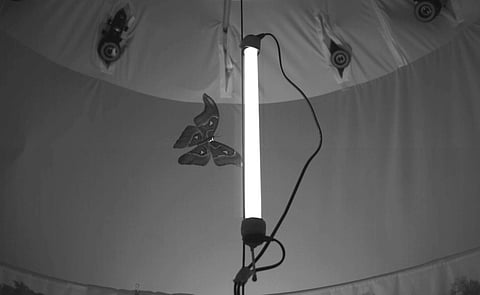

Moths and other insects are drawn to lights at night as reliably as planets orbit stars. Entomologists have long exploited this fact by setting out light traps whenever they want to collect insects. Poets have reached for the image of a moth drawn to flame to signify self-destructive behavior in works ranging from “The Merchant of Venice” to the Hindu epic the Bhagavad Gita. Ecologists, more recently, have begun to worry that the lure of artificial lights across Earth’s nighttime surface may partially explain why insects are in global decline. But, despite all this, scientists still didn’t know why.
“A lot of entomologists get asked this all the time,” Avalon Owens, a biologist at Harvard, said. One prevailing theory, popular but flawed, she said, is that flying insects confuse our porch lights for the moon or another celestial body, and their sense of navigation gets scrambled. Another idea is that lights at night look like glimpses of daylight through a thicket of vegetation, prompting insects to try to “escape” by making a beeline toward what they think is open space.
Now, though, a new answer has the entomology world abuzz. A team led by biologists Samuel Fabian at Imperial College London and Yash Sondhi at Florida International University argue that when many insects see a bright light at night, they believe they’ve found the direction of the sky and attempt to orient themselves along an up-and-down axis. That instinct prompts them to roll their backs toward the light, mistakenly in cases when the source of illumination is on the ground or mounted horizontally, causing them to go into endless, banking turns like a tiny airplane or to crash-land.
The findings were published in a paper that was uploaded to the bioRxiv server but has yet to be peer-reviewed.
In the daytime, entomologists knew, such directional instincts help flying insects stay level by keeping their backs pointed toward sunlight, even during aerial maneuvers. The new analysis, though, shows that lights at night appear to hijack this instinct.
To arrive at this conclusion, the scientists took high-speed, lowlight video of dragonflies, butterflies and moths flying around light bulbs both in the lab and in the cloud forests of Costa Rica. Sometimes the insects would start making circular loops like an orbiting moon. Other times the insects would pass the bulbs, then tilt upward into a stall. Or they would fly above the bulbs, then flip themselves upside down and nose-dive toward the ground.
In each case, though, the slowed-down footage showed that the insects always tried to keep their backs aimed toward the light, a result the team confirmed by gluing little motion trackers on the insects. In turn, the team found through computerized flight simulations that those inadvertent roll maneuvers could explain the bugs’ looping, trapped flight trajectories.
“This is the best argument so far for what explains this behavior,” said Tyson Hedrick, an expert in the aerodynamics of insect flight at the University of North Carolina who said he had previously favored the idea that lights interfere with the celestial navigation of insects. “It’s one of these things that we all sort of think we know about nature,” he said, “and it’s getting overturned.”
Joshua Sokol is a journalist with NYT©2023
The New York Times
Visit news.dtnext.in to explore our interactive epaper!
Download the DT Next app for more exciting features!
Click here for iOS
Click here for Android